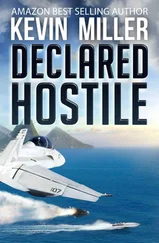Maybe she would.
Wilson and Weed awoke midmorning and were among the first in line for lunch. They joined most of the Carrier Air Wing Four aircrew, many of whom they recognized from the previous long day’s planning in CVIC. The mood was quiet, if not a little tense. Most of the aviators were still tired after a fitful night’s sleep, and each one was preoccupied with thoughts of the Iranian coast. Wilson remembered a similar feeling just before launch time on the first night of Iraqi Freedom , and all the aircrew knew that tonight would be much hotter than “routine” patrols over Iraq. After lunch, the aircrew spent time checking gear and studying their procedures. Many of them also tried to catch a few moments to write a note home, some writing “the letter” to their families in case they did not return. Wilson already had such a letter for Mary stashed in his desk drawer in a sealed envelope.
Wilson was always amused, if not a little put off, by the disposition of the sailors before major combat. To the majority of them, many of them teenagers, it was just another day at sea. Their major goal, from the time they rolled out of the rack, was to survive the day, mentally if not physically. They thought of the pilots as the guys who flew the planes over the horizon and returned hours later. Who knew what they did, and if knowing was not going to make the job any easier, then who cared? Over four months into the deployment, fatigue and tension wore on everyone, and sailors bore the brunt of it.
While the aviators were well aware of the historic significance and geopolitical consequences of the missions they flew, the sailors, for the most part, were oblivious. Wilson smiled at the idea that, despite what they may think, the aviators were not the center of the universe to thousands of kids just trying to make it through the regimentation of another day at sea. The young sailors were proud of their roles and welcomed opportunities to learn more about the aviators’ missions, but not all of their leaders took the time to visit them in their shops and explain. Time, after all, was a precious commodity at sea for everybody.
For Wilson and his team the afternoon went fast as they folded updates on the tactical situation, the weather, and expected ship’s position into the strike plan. When Wilson joined Olive and Dutch afterwards for dinner, he sensed the disposition of the air wing had picked up and ranged from quiet confidence to eager anticipation. Wilson was familiar with those feelings, too. Let’s get this show on the road.
After he finished dinner, Wilson went below, for no particular reason other than he wanted to be alone for a few moments. He stepped inside his stateroom and flicked on his desk lamp.
He looked at Mary’s framed picture on his desk, his favorite of her at the strike fighter ball. She had looked stunning that night. He leaned in toward her image and stared at her beauty, drinking her in, trying to seek comfort.
Wilson fought against the empty feeling in his stomach, the foreboding tension always felt prior to combat in a high-threat environment. What will Iran throw at us? What are they preparing up there? He answered his own question. Bandar Abbas is going to be hot. Compartmentalize, dammit!
Wilson stood to head aft to the ready room for the Skipper’s strike brief, but paused to pray instead. Holding his folded hands against his chin, he closed his eyes and whispered, “Please, God, bring us all back. Let us do well. Give us strength. And your will be done, not ours.”
Before he flicked off the light, Wilson took another long look at Mary’s photo, and said, “I’ll come back to you, baby.” He glanced at his watch: four-and-a-half hours until launch.
* * *
On a whim, Wilson decided to take the long way to the ready room — via the hangar bay. Sunset was in 15 minutes, and sunsets on the open ocean were often breathtaking in their beauty. Going this way he could look out to the horizon through the open elevator doors.
He walked aft, through a hatch, and down two ladders to the hangar bay. Winding his way through the parked yellow tractors, drop tanks on dollies, hydraulic jacks and various other pieces of hangar bay equipment, Wilson walked past a Raven aircraft, 401 . Wearing a respirator, a young, female petty officer maneuvered an orbital sander on a piece of wing in preparation for some routine touch-up paint. He looked at the name on the cockpit:
CDR STEVE LASSITER
CAJUN
Wilson realized the skipper wasn’t going to be flying “his” aircraft that night. While 401 had a reputation as a solid flyer, maintenance would put Cajun, and the rest of the pilots, in full mission-ready aircraft, right now being loaded and fueled topside.
Wilson walked under a Prowler tail and over to the Elevator 1 opening. The sea was a deep blue, and where it met the sky, he saw the white superstructure of a tanker, brilliant from the reflected sunlight, peeking over the horizon. Realizing the carrier was pointing north, he scanned for other ships and noted another tanker, this one less than 10 miles away, and heading east. Several miles away to the southeast, he recognized the familiar outline of a guided missile destroyer in escort, paralleling the carrier’s course. Further east, dramatic cumulus buildups, illuminated by sunlight, formed a sharp line in the sky, all the way to the horizon. Great visibility.
Wilson savored moments like this, alone with his thoughts in the vastness of the Indian Ocean. But he couldn’t help thinking of what was in store after the sun set: the tension of the man-up, taxiing among dozens of loaded strike aircraft, joining up in the darkness and pushing toward Bandar Abbas, the radar cursor sweeping like a metronome as it searched for contacts, with terse, clipped radio transmissions interrupting the electronic hum of the cockpit. SAMs . They would see SAMs tonight, probably in numbers. Wilson imagined his RWR lighting up, accompanied by loud deedles in the headset, if his aircraft were caught in the electronic snare of a missile-tracking radar. His head would snap in the direction of arrival in a frantic search to pick it up visually and maneuver to defeat it. Known AAA sites surrounded the target area. It was also likely the American formations would be ragged and confused once they reached the release points. He visualized more arcs of AAA rising up to meet them, giant rapiers swinging through a swarm of bees in a desperate effort to hit one, just one. Would it be him?
And MiGs. Would the Iranians launch their fighters tonight? All of the fighter aircrew actually welcomed a fight, and prayed for the chance to down a MiG or Tomcat or Phantom . So did Wilson, but in the back of his mind, he knew more than the others how formidable the MiG-35 could be: invisible to radar, possessing an incredible thrust-to-weight ratio, slow-speed maneuverability. He wondered if the IRIAF would deploy them down here? What is Hariri thinking right now?
Enough! Wilson scolded himself, still trying to scan the horizon out to 1,000 miles. He was the operations officer in a deployed Hornet squadron and a TOPGUN instructor with as much green ink as anyone in the air wing. You can do this , he thought. If anything, it should be the Iranians who are worried right now, knowing we are just over the horizon . And if there was a golden BB out there for him, then so be it. He could not be more prepared for this moment.
Wilson said another prayer. God, please take this anxiety from my shoulders. Please allow me to do Your will now and always. And please bring us all back. Your will be done. Amen.
Читать дальше












